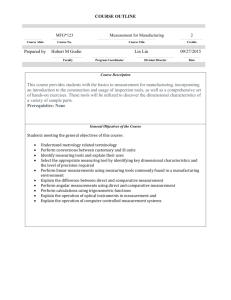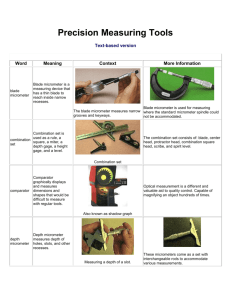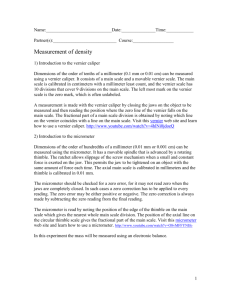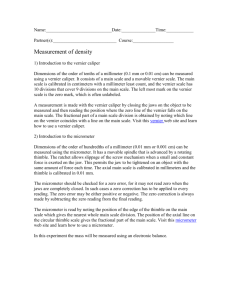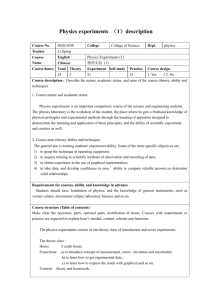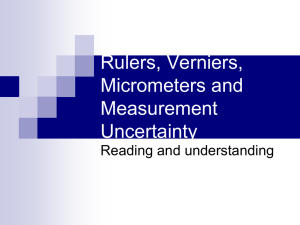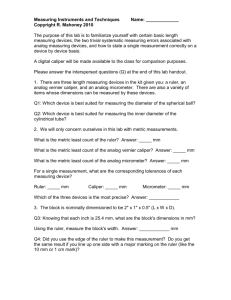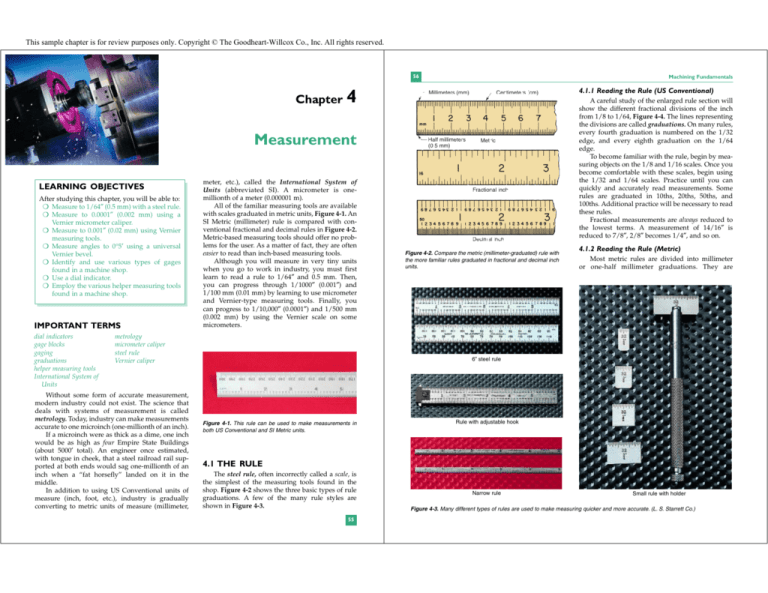
This sample chapter is for review purposes only. Copyright © The Goodheart-Willcox Co., Inc. All rights reserved.
56
Chapter
4
Measurement
LEARNING OBJECTIVES
After studying this chapter, you will be able to:
H Measure to 1/64″ (0.5 mm) with a steel rule.
H Measure to 0.0001″ (0.002 mm) using a
Vernier micrometer caliper.
H Measure to 0.001″ (0.02 mm) using Vernier
measuring tools.
H Measure angles to 0°5′ using a universal
Vernier bevel.
H Identify and use various types of gages
found in a machine shop.
H Use a dial indicator.
H Employ the various helper measuring tools
found in a machine shop.
IMPORTANT TERMS
dial indicators
gage blocks
gaging
graduations
helper measuring tools
International System of
Units
meter, etc.), called the International System of
Units (abbreviated SI). A micrometer is onemillionth of a meter (0.000001 m).
All of the familiar measuring tools are available
with scales graduated in metric units, Figure 4-1. An
SI Metric (millimeter) rule is compared with conventional fractional and decimal rules in Figure 4-2.
Metric-based measuring tools should offer no problems for the user. As a matter of fact, they are often
easier to read than inch-based measuring tools.
Although you will measure in very tiny units
when you go to work in industry, you must first
learn to read a rule to 1/64″ and 0.5 mm. Then,
you can progress through 1/1000″ (0.001″) and
1/100 mm (0.01 mm) by learning to use micrometer
and Vernier-type measuring tools. Finally, you
can progress to 1/10,000″ (0.0001″) and 1/500 mm
(0.002 mm) by using the Vernier scale on some
micrometers.
metrology
micrometer caliper
steel rule
Vernier caliper
Without some form of accurate measurement,
modern industry could not exist. The science that
deals with systems of measurement is called
metrology. Today, industry can make measurements
accurate to one microinch (one-millionth of an inch).
If a microinch were as thick as a dime, one inch
would be as high as four Empire State Buildings
(about 5000′ total). An engineer once estimated,
with tongue in cheek, that a steel railroad rail supported at both ends would sag one-millionth of an
inch when a “fat horsefly” landed on it in the
middle.
In addition to using US Conventional units of
measure (inch, foot, etc.), industry is gradually
converting to metric units of measure (millimeter,
Machining Fundamentals
Millimeters (mm)
Half millimeters
(0.5 mm)
Centimeters (cm)
Metric
Fractional inch
Decimal inch
Figure 4-2. Compare the metric (millimeter-graduated) rule with
the more familiar rules graduated in fractional and decimal inch
units.
4.1.1 Reading the Rule (US Conventional)
A careful study of the enlarged rule section will
show the different fractional divisions of the inch
from 1/8 to 1/64, Figure 4-4. The lines representing
the divisions are called graduations. On many rules,
every fourth graduation is numbered on the 1/32
edge, and every eighth graduation on the 1/64
edge.
To become familiar with the rule, begin by measuring objects on the 1/8 and 1/16 scales. Once you
become comfortable with these scales, begin using
the 1/32 and 1/64 scales. Practice until you can
quickly and accurately read measurements. Some
rules are graduated in 10ths, 20ths, 50ths, and
100ths. Additional practice will be necessary to read
these rules.
Fractional measurements are always reduced to
the lowest terms. A measurement of 14/16″ is
reduced to 7/8″, 2/8″ becomes 1/4″, and so on.
4.1.2 Reading the Rule (Metric)
Most metric rules are divided into millimeter
or one-half millimeter graduations. They are
6” steel rule
Figure 4-1. This rule can be used to make measurements in
both US Conventional and SI Metric units.
Rule with adjustable hook
4.1 THE RULE
The steel rule, often incorrectly called a scale, is
the simplest of the measuring tools found in the
shop. Figure 4-2 shows the three basic types of rule
graduations. A few of the many rule styles are
shown in Figure 4-3.
55
Narrow rule
Small rule with holder
Figure 4-3. Many different types of rules are used to make measuring quicker and more accurate. (L. S. Starrett Co.)
Chapter 4
57
Measurement
• Wipe steel rules with an oily cloth before storing. This will prevent rust. If the rule is to be
stored for a prolonged period, coat it with
wax or rust preventative.
• Clean the rule with steel wool to keep the
graduations legible.
• Make measurements and tool settings from
the 1″ line (10 mm line on a metric rule) or
other major graduations, rather than from the
end of the rule.
• Store rules separately. Do not throw them in a
drawer with other tools.
• Use the rule with care to protect the ends from
nicks and wear.
• Use the correct rule for the job being done.
numbered every 10 mm. See Figure 4-5. The measurement is determined by counting the number of
millimeters.
1
1
16
1
8
1
32
1
11″
2 16
7″
16
11″
32
2
3″
32
58
Machining Fundamentals
The micrometer caliper, also known as a “mike,”
is a precision tool capable of measuring to 0.001″ or
0.01 mm. When fitted with a Vernier scale, it will
read to 0.0001″ or 0.002 mm.
4.2.1 Types of Micrometers
Micrometers are produced in a wide variety of
models. Digital display is included in many
micrometers, making measuring easier. Some of the
most popular models are the following:
• An outside micrometer measures external
diameters and thickness, Figure 4-7.
4.2 THE MICROMETER CALIPER
1
64
Figure 4-4. These are the fractional graduations found on a
rule. Measurements are taken by counting the number of
graduations.
1.0 mm
0.5 mm
44 mm
A Frenchman, Jean Palmer, devised and
patented a measuring tool that made use of a screw
thread, making it possible to read measurements
quickly and accurately without calculations. It
incorporated a series of engraved lines on the sleeve
and around the thimble. The device, called Systeme
Palmer, is the basis for the modern micrometer
caliper, Figure 4-6.
Figure 4-7. This digital outside micrometer can be used to
measure in both US Conventional and SI Metric units.
(Mitutoyo/MTI Corp.)
Figure 4-8. Inside micrometers. A—A conventional inside
micrometer. B—The caliper jaws on this inside micrometer allow
quick and accurate measurements. The divisions on the sleeve
are numbered in the reverse order of a conventional outside
micrometer. (L. S. Starrett Co.)
69 mm
245.5 mm
A
Figure 4-5. Most metric rules are graduated in millimeters and
half-millimeters. They are available in a variety of sizes.
4.1.3 Care of the Rule
The steel rule is precision-made and, like all
tools, its accuracy depends upon the care it receives.
Here are a few suggestions:
• Use the rule for measurements only. Do not
adjust screws or open paint cans with it. Be
careful not to bend your rule.
• Keep the rule clear of moving machinery.
Never use it to clean metal chips as they form
on the cutting tool. This is extremely dangerous and will ruin the rule.
• Avoid laying other tools on the rule.
B
Figure 4-6. The micrometer caliper, past and present.
A—A drawing of the Systeme Palmer measuring device.
B—These modern micrometer calipers operate on the same
principle as the original 1848 invention.
• An inside micrometer has many uses, including measuring internal diameters of cylinders, rings, and slots. The range of a
conventional inside micrometer can be
extended by fitting longer rods to the
micrometer head. The range of a jaw-type
inside micrometer is limited to 1″ or 25 mm.
The jaw-type inside micrometer has a scale
graduated from right to left. See Figure 4-8.
• A micrometer depth gage measures the depths
of holes, slots, and projections. See Figure 4-9.
The measuring range can be increased by
changing to longer spindles. Measurements
are read from right to left.
• A screw-thread micrometer has a pointed
spindle and a double-V anvil shaped to contact the screw thread, Figure 4-10. It measures
the pitch diameter of the thread, which equals
the outside (major) diameter of the thread
minus the depth of one thread. Since each
thread micrometer is designed to measure
only a limited number of threads per inch, a
set of thread micrometers is necessary to measure a full range of thread pitches.
Figure 4-9. A standard micrometer depth gage.
• A chamfer micrometer will accurately
measure countersunk holes and other
chamfer-type measurements. With fastener
Chapter 4
59
Measurement
Figure 4-10. This screw thread micrometer can measure
threads as wide as 7/8″. (L. S. Starrett Co.)
tolerances so critical on some aerospace and
other applications, it is important that countersunk holes and tapers on fasteners meet
specifications. A chamfer micrometer makes it
possible to check these critical areas.
Special micrometers are available for other
applications. These micrometers are devised to
handle nonstandard measurement tasks.
The line engraved lengthwise on the sleeve is
divided into 40 equal parts per inch (corresponding
to the number of threads per inch on the spindle).
Each vertical line equals 1/40″, or 0.025″. Every
fourth division is numbered, representing 0.100″,
0.200″, etc.
The beveled edge of the thimble is divided into
25 equal parts around its circumference. Each division equals 1/1000″ (0.001″). On some micrometers,
every division is numbered, while every fifth division is numbered on others.
The micrometer is read by recording the highest
number on the sleeve (1 = 0.100, 2 = 0.200, etc.). To
this number, add the number of vertical lines visible
between the number and thimble edge (1 = 0.025,
2 = 0.050, etc.). To this total, add the number of thousandths indicated by the line that coincides with the
horizontal sleeve line.
60
Machining Fundamentals
0.353″
Example 3
0.0002
Add the readings from the sleeve and the thimble:
3 large graduations:
3 0.100 = 0.300
2 small graduations:
2 0.025 = 0.050
3 thimble graduations:
3 0.001 = 0.003
Total mike reading
= 0.353″
0.0120
4.2.3 Reading a Vernier Micrometer
On occasion, it is necessary to measure more
precisely than 0.001″. A Vernier micrometer caliper
is used in these situations. This micrometer has a
third scale around the sleeve that will furnish the
1/10,000″ (0.0001″) reading. See Figure 4-12.
0.2000
0.0750
0.2000
0.0750
0.0120
0.0002
Reading is 0.2872″
Figure 4-13. How to read a Vernier micrometer caliper. Add the
total reading in thousandths, then observe which of the lines on
the Vernier scale coincides with a line on the thimble. In this
case, it is the second line, so 0.0002 is added to the reading.
Vernier scale lines
0.458″
Example 1
4.2.2 Reading an Inch-Based Micrometer
A micrometer uses a very precisely made screw
thread that rotates in a fixed nut. The screw thread
is ground on the spindle and is attached to the
thimble. The spindle advances or recedes from the
anvil as the thimble is rotated. See Figure 4-11. The
threaded section has 40 threads per inch; therefore,
each revolution of the thimble moves the spindle
1/40″ (0.025″).
Lock nut
Anvil
Sleeve Thimble
Spindle
Add the readings from the sleeve and the thimble:
4 large graduations:
4 0.100 = 0.400
2 small graduations:
2 0.025 = 0.050
8 thimble graduations: 8 0.001 = 0.008
Total mike reading
= 0.458″
5.00 mm
Ratchet
stop
0.289″
Example 2
Frame
Figure 4-11. Basic parts of a micrometer caliper.
Figure 4-12. A Vernier micrometer caliper includes a Vernier
scale on the sleeve.
Add the readings from the sleeve and the thimble:
2 large graduations:
2 0.100 = 0.200
3 small graduations:
3 0.025 = 0.075
14 thimble graduations: 14 0.001 = 0.014
Total mike reading
= 0.289″
The Vernier scale has 11 parallel lines that
occupy the same space as 10 lines on the thimble.
The lines around the sleeve are numbered 1 to 10.
The difference between the spaces on the sleeve and
those on the thimble is one-tenth of a thousandth of
an inch.
To read the Vernier scale, first obtain the thousandths reading, then observe which of the lines on
the Vernier scale coincides (lines up) with a line on
the thimble. Only one of them can line up. If the line
is 1, add 0.0001 to the reading; if line 2, add 0.0002 to
the reading, etc. See Figure 4-13.
4.2.4 Reading a Metric-Based Micrometer
The metric-based micrometer is read as shown
in Figure 4-14. If you are able to read the conven-
0.28 mm
0.50 mm
5.00
0.50
0.28
Reading is 5.78 mm
Figure 4-14. To read a metric micrometer, add the total reading
in millimeters visible on the sleeve to the reading of hundredths
of a millimeter, indicated by the graduation on the thimble. Note
that the thimble reading coincides with the longitudinal line on
the micrometer sleeve.
tional inch-based micrometer, reading the metricbased tool will offer no difficulties.
Chapter 4
61
Measurement
62
Machining Fundamentals
• A lock nut is used when several identical
parts are to be gaged. Refer again to Figure
4-11. The nut locks the spindle into place.
Gaging parts with a micrometer locked at the
proper setting is an easy way to determine
whether the pieces are sized correctly.
4.2.5 Reading a Metric Vernier Micrometer
Metric Vernier micrometers are read in the same
way as standard metric micrometers. However,
using the Vernier scale on the sleeve, an additional
reading of two-thousandths of a millimeter can be
obtained, Figure 4-15.
reverse order of the graduations on an outside
micrometer. See Figure 4-18. The graduations under
the thimble must be read, rather than those that are
exposed.
4.2.7 Reading an Inside Micrometer
To get a correct reading with an inside micrometer, it is important that the tool be held square
across the diameter of the work. It must be positioned so that it will measure across the diameter on
the exact center, Figure 4-17.
Figure 4-18. A micrometer depth gage. When making measurements with a depth gage, remember that the graduations
are in reverse order. This gage indicates a depth of 0.250.
0.004 mm
4.2.9 Care of a Micrometer
7.000 mm
0.310 mm
0.500 mm
7.000
0.500
0.310
0.004
Reading is 7.814 mm
Figure 4-15. Reading a metric-based Vernier micrometer
caliper. To the regular reading in hundredths of a millimeter
(0.01), add the reading from the Vernier scale that coincides
with a line on the thimble. Each line on the Vernier scale is equal
to two thousandths of a millimeter (0.002 mm).
4.2.6 Using the Micrometer
The proper way to hold a micrometer when
making a measurement is shown in Figure 4-16. The
work is placed into position, and the thimble
rotated until the part is clamped lightly between the
anvil and spindle. Guard against excessive pressure,
which will cause an erroneous reading. Some
micrometers have features to help regulate pressure:
• A ratchet stop is used to rotate the spindle.
When the pressure reaches a predetermined
amount, the ratchet stop slips and prevents
further spindle turning. Uniform contact
pressure with the work is ensured, even if different people use the same micrometer. Refer
again to Figure 4-11.
• A friction thimble may be built into the upper
section of the thimble. This produces the same
Figure 4-17. Using an inside micrometer. Extension rods can be
added to increase the tool’s measuring range.
B
Figure 4-16. Proper technique of handling a micrometer.
A—Use very light pressure when turning the thimble. B—When
the piece being measured must also be held, position the
micrometer as shown, with a finger in the micrometer frame.
Measurement is made by holding one end of the
tool in place and then “feeling” for the maximum
possible setting by moving the other end from left to
right, and then in and out of the opening. The measurement is made when no left or right movement is
felt, and a slight drag is noticeable on the in-and-out
swing. It may be necessary to take several readings
and average them.
4.2.8 Reading a Micrometer Depth Gage
results as the ratchet stop but permits onehanded use of the micrometer.
Be sure to read a micrometer depth gage correctly. The graduations on this measuring tool are in
Micrometers are precision instruments and
must be handled with care. The following techniques are recommended:
• Place the micrometer on the work carefully so
the faces of the anvil and spindle will not be
damaged. The same applies when removing
the tool after a measurement has been made.
• Keep the micrometer clean. Wipe it with a
slightly oiled cloth to prevent rust and tarnish. A drop of light oil on the screw thread
will keep the tool operating smoothly.
• Avoid “springing” a micrometer by applying
too much pressure when you are making a
measurement.
• Clean the anvil and spindle faces before use.
This can be done with a soft cloth or by lightly
closing the jaws on a clean piece of paper and
drawing the paper out.
• Check for accuracy by closing the spindle
gently on the anvil and note whether the zero
line on the thimble coincides with the zero on
the sleeve. If they are not aligned, follow the
manufacturer’s recommended adjustments.
• Avoid placing a micrometer where it may fall
on the floor or have other tools placed on it.
• If the micrometer must be opened or closed a
considerable distance, do not “twirl” the
frame; gently roll the thimble with your palm.
See Figure 4-19.
• Never attempt to make a micrometer reading
until a machine has come to a complete stop.
• Clean and oil the tool if it is to be stored for
some time. If possible, place the micrometer
in a small box for protection.
Chapter 4
Measurement
63
64
Machining Fundamentals
Figure 4-19. Micrometers must be treated carefully. Roll the
micrometer thimble on the palm of your hand if the instrument
must be opened or closed a considerable distance.
4.3 VERNIER MEASURING TOOLS
The Vernier principle of measuring was named
for its inventor, Pierre Vernier, a French mathematician. The Vernier caliper can make accurate
measurements to 1/1000″ (0.001″) and 1/50 mm
(0.02 mm). See Figure 4-20.
Figure 4-21. Vernier calipers can be used to make both internal
and external measurements. (L. S. Starrett Co.)
A
C
A
B
Figure 4-20. Vernier calipers can be used to make very accurate measurements. A—Standard Vernier caliper. B—Modern
digital calipers are easier to read than mechanical instruments.
The design of the tool permits measurements to
be made over a large range of sizes. It is manufactured as a standard item in 6″, 12″, 24″, 36″, and 48″
lengths. SI Metric Vernier calipers are available in
150 mm, 300 mm, and 600 mm lengths. The 6″, 12″,
150 mm, and 300 mm sizes are most commonly
used. Unlike the micrometer caliper, the Vernier
caliper can be used for both inside and outside measurements, Figure 4-21.
The following measuring instruments may
include a Vernier scale:
• Height and depth gages are used for layout
work and to inspect the locations of features.
See Figure 4-22.
• Gear tooth calipers are used to measure gear
teeth and threading tools, Figure 4-23.
• Universal Vernier bevel protractors are used
for the layout and inspection of angles,
Figure 4-24.
Vernier measuring tools, with the exception of
the Vernier bevel protractor, consist of a graduated
beam with fixed jaw or base and a Vernier slide
assembly. The Vernier slide assembly is composed
of a movable jaw or scribe, Vernier plate, and clamping screws. The slide moves as a unit along the
beam.
Unlike other Vernier measuring tools, the beam
of the Vernier caliper is graduated on both sides.
One side is for making outside measurements, the
other for inside measurements. Many of the newer
Vernier measuring tools are graduated to make both
inch and millimeter measurements.
Figure 4-22. Many instruments are equipped with a Vernier
scale. A—Height gage. B—Depth gage. C—The digital readout
on this type of height gage serves the same function as a standard Vernier scale. (L. S. Starrett Co.)
B
4.3.1 Reading an Inch-Based Vernier Scale
These measuring tools are available with either
25-division or 50-division Vernier plates. Both plates
can be read to 0.001″.
On measuring tools using the 25-division Vernier
plate, every inch section on the beam is graduated
Figure 4-23. Gear tooth Vernier calipers are used to measure
gear teeth, form tools, and threaded tools. (L. S. Starrett Co.)
Chapter 4
65
Measurement
Figure 4-24. A universal Vernier bevel protractor is used to
accurately measure angles. (L. S. Starrett Co.)
into 40 equal parts. Each graduation is 1/40″
(0.025″). Every fourth division, representing 0.100″,
is numbered.
There are 25 divisions on the Vernier plate.
Every fifth line is numbered: 5, 10, 15, 20, and 25.
The 25 divisions occupy the same space as 24 divisions on the beam. This slight difference, equal to
0.001 (1/1000″) per division, is the basis of the
Vernier principle of measuring.
To read a 25-division Vernier plate measuring
tool, note how many inches (1, 2, 3, etc.), tenths
(0.100, 0.200, etc.), and fortieths (0.025, 0.050, or
0.075) there are between the “0” on the Vernier scale
and the “0” line on the beam, then add them. Then
count the number of graduations (each graduation
equals 0.001″) that lie between the “0” line on the
Vernier plate and the line that coincides (corresponds exactly) with a line on the beam. Only one
line will coincide. Add this to the above total for the
reading.
0.300
0.050
0.018
2.000
The “0” line on the Vernier plate is:
Past the 2:
21
= 2.000
Past the 3:
3 0.100
= 0.300
Plus 2 graduations: 2 0.025
= 0.050
Plus 18 Vernier scale
graduations:
18 0.001
= 0.018
Total reading
= 2.368″
On the 50-division Vernier plate, every second
graduation between the inch lines is numbered, and
equals 0.100″. The unnumbered graduations equal
0.050″.
The Vernier plate is graduated into 50 parts,
each representing 0.001″. Every fifth line is numbered: 5, 10, 15 . . . 40, 45, and 50.
To read a 50-division Vernier measuring tool,
first count how many inches, tenths (0.100), and
twentieths (0.050) there are between the “0” line on
the beam, and the “0” line on the Vernier plate. Then
add them. Then count the number of 0.001 graduations on the Vernier plate from its “0” line to the line
that coincides with a line on the beam. Add this to
the above total.
30.00
Machining Fundamentals
9.00
0.28
30.00
9.00
0.28
Reading is 39.28 mm
Figure 4-25. How to read a 25-division metric-based Vernier
scale. Readings on the scale are obtained in units of two hundredths of a millimeter (0.02 mm).
9.00
0.28
30.00
Figure 4-27. Dial calipers provide direct readings of measurements. (L.S. Starrett Co.)
30.00
9.00
0.28
Reading is 39.28 mm
2.000
0.200
0.050
0.015
2.000
0.200
0.050
0.015
Reading is 2.265″
The “0” line on the Vernier plate is:
Past the 2:
2 1.000
Past the 2:
2 0.100
Plus one graduation: 1 0.050
Plus 15 Vernier scale
graduations:
15 0.001
Total reading
Figure 4-26. How to read a 50-division metric-based Vernier
scale. Each division equals two hundredths of a millimeter
(0.02 mm).
= 2.000
= 0.200
= 0.050
= 0.015
= 2.265″
The principles used in reading metric Vernier
measuring tools are the same as those used for
US Conventional measure. However, the readings
on the Vernier scale are obtained in 0.02 mm precision. A 25-division Vernier scale is illustrated in
Figure 4-25, while a 50-division scale is described in
Figure 4-26.
The beam is graduated into 0.10″ increments.
The caliper dial is graduated into 100 divisions. The
reading is made by combining the division on the
beam and the dial reading.
The dial hand makes one full revolution for each
0.10″ movement. Each dial graduation, therefore,
represents 1/100 of 0.10″, or 0.001″. On the metric
version, each dial graduation represents 0.02 mm.
4.3.4 Universal Vernier Bevel Protractor
4.3.3 Using the Vernier Caliper
4.3.2 Reading a Metric-Based Vernier Scale
2.000
0.300
0.050
0.018
Reading is 2.368″
66
As with any precision tool, a Vernier caliper
must not be forced on the work. Slide the Vernier
assembly until the jaws nearly contact the section
being measured. Lock the clamping screw. Make the
tool adjustment with the fine adjusting nut. The
jaws must contact the work firmly, but not tightly.
Lock the slide on the beam. Carefully remove
the tool from the work and make your reading. For
precise layout work, divider and trammel point settings are located on the outside measuring scale and
on the slide assembly.
Dial calipers. These direct-reading instruments
resemble Vernier calipers. They can be used to make
outside, inside, and depth measurements (with the
addition of a depth attachment). A lock permits the
tool to be employed for repetitive measurements.
See Figure 4-27.
A quick review of the circles, angles, and units of
measurement associated with them will help in
understanding how to read a universal Vernier
bevel protractor.
• Degree (°)—Regardless of its size, a circle
contains 360°. Angles are also measured by
degrees.
• Minute (′)—A minute represents a fractional
part of a degree. If a degree is divided into
60 equal parts, each part is one minute. A
foot mark (′) is used to signify minutes
(e.g. 30°15’).
• Second (″)—Minutes are divided into smaller
units known as seconds. There are 60 seconds
in one minute. An angular measurement written in degrees, minutes, and seconds appears
as 36°18’22″. This would read “36 degrees,
18 minutes, and 22 seconds.”
Chapter 4
67
Measurement
A universal bevel protractor has several parts: a
dial, a base or stock, and a sliding blade. The dial is
graduated into degrees, and the blade can be
extended in either direction and set at any angle to
the stock. The blade can be locked against the dial
by tightening the blade clamp nut. The blade and
dial can be rotated as a unit to any desired position,
and locked by tightening the dial clamp nut.
The protractor dial is graduated into 360° and
reads from 0° to 90° and then back down to 0°.
Every ten degree division is numbered, and every
five degrees is indicated by a fine line longer than
those on either side. The Vernier scale is divided
into twelve equal parts on each side of the “0.”
Every third graduation is numbered (0, 15, 30, 45,
60), representing minutes. Each division equals five
minutes. Since each degree is divided into 60 minutes, one division is equal to 5/60 of a degree.
To read the protractor, note the number of
degrees that can be read up to the “0” on the Vernier
plate. To this, add the number of minutes indicated
by the line beyond the “0” on the Vernier plate that
aligns exactly with a line on the dial.
50°00′
0°20′
50°00′
0°20′
Reading is 50°20′
In this example the “0” is past the 50° mark,
and the Vernier scale aligns at the 20′ mark.
Therefore, the measurement is 50°20′.
4.3.5 Care of Vernier Tools
Reasonable care in handling these expensive
tools will maintain their accuracy.
• Wipe the instrument with a soft, lint-free cloth
before using. This will prevent dirt and grit
from being ground in, which could eventually
affect the accuracy of the tool.
• Wipe the tool with a lightly oiled, soft cloth
after use and before storage.
• Store the tool in its case.
• Never force the tool when you are making
measurements.
• Use a magnifying glass or a jeweler’s loupe to
make Vernier readings. Hold the tool so the
light is reflected on the scale.
• Handle the tool as little as possible. Sweat and
body acids cause rusting and staining.
• Periodically check for accuracy. Use a measuring standard, Jo-block, or ground parallel.
Return the tool to the manufacturer for
adjustments and repairs.
• Lay Vernier height gages on their side when
not in use. Then there will be no danger that
they will be knocked over and damaged.
68
Machining Fundamentals
Figure 4-28. A double end cylindrical plug gage.
4.4 GAGES
It is impractical to check every dimension on
every manufactured part with conventional measuring tools. Specialized tools, such as plug gages,
ring gages, and optical gages are used instead.
These gaging devices can quickly determine
whether the dimensions of a manufactured part are
within specified limits or tolerances.
Measuring requires the skillful use of precision
measuring tools to determine the exact geometric
size of the piece. Gaging involves checking parts
with various gages. Gaging simply shows whether
the piece is made within the specified tolerances.
When great numbers of an item with several
critical dimensions are manufactured, it might not
be possible to check each piece. It then becomes necessary to decide how many randomly selected
pieces must be checked to ensure satisfactory quality and adherence to specifications. This technique
is called statistical quality control.
Always handle gages carefully. If dropped or
mishandled, the accuracy of the device could be
affected. Gages provide a method of checking your
work and are very important tools.
4.4.1 Plug Gage
Plug gages are used to check whether hole
diameters are within specified tolerances. The
double-end cylindrical plug gage has two gaging
members known as go and no-go plugs, Figure 4-28.
The go plug should enter the hole with little or no
interference. The no-go plug should not fit.
The go plug is longer than the no-go plug.
A progressive plug gage, or step plug gage, has the
go and no-go plugs on the same end. This gage is
able to check the dimensions in one motion. See
Figure 4-29.
Figure 4-29. A step plug gage can check for oversize and
undersize in a single test.
4.4.2 Ring Gage
External diameters are checked with ring gages.
The go and no-go ring gages are separate units, and
can be distinguished from each other by a groove
cut on the knurled outer surface of the no-go gage.
Refer to Figure 4-30.
On ring gages, the gage tolerance is the reverse
of plug gages. The opening of the go gage is larger
than the opening for the no-go gage.
Figure 4-31. An adjustable snap gage. (Taft-Pierce Co.)
Gage size
For
checking
O.D.
For
checking
I.D.
Figure 4-30. Ring gages. The larger sizes are cut away to
reduce weight. (Standard Tool Co.)
4.4.3 Snap Gage
A snap gage serves the same purpose as a ring
gage. Snap gages are designed to check internal
diameters, external diameters, or both. There are
three general types:
• An adjustable snap gage can be adjusted
through a range of sizes. See Figure 4-31.
• A nonadjustable snap gage is made for one
specific size. See Figure 4-32.
Figure 4-32. Diagram of a nonadjustable snap gage. A—A combination internal-external nonadjustable snap gage. B—An
external nonadjustable snap gage.
Chapter 4
69
Measurement
70
Machining Fundamentals
• Wipe gage blocks with a soft cloth or chamois
treated with oil. Be sure the oil is one recommended by the gage manufacturer. See Figure
4-37C.
• A dial indicator snap gage measures the
amount of variation in the part measurement.
The dial face has a double row of graduations
reading in opposite directions from zero.
Minus graduations are red and plus graduations are black. Both adjustable and nonadjustable indicating snap gages are available.
See Figure 4-33.
On snap gages, the anvils should be narrower
than the work being measured. This will avoid
uneven wear on the measuring surfaces.
A
4.5 DIAL INDICATORS
B
Figure 4-35. A typical set of gage blocks.
(Federal Products Co.)
Federal Accuracy Grades
Tolerance
Accuracy
Former
US Conventional Metric system
grade
designation system (inch)
(millimeter)
C
Figure 4-33. A dial indicator snap gage. (L.S. Starrett Co.)
4.4.4 Thread Gages
Several types of gages are used to check screw
thread fits and tolerances. These gages are similar to
the gages already discussed:
• Thread plug gage.
• Thread ring gage.
• Thread roll snap gage.
These gages are illustrated in Figure 4-34.
4.4.5 Gage Blocks
Gage blocks, commonly known as Jo-blocks or
Johansson blocks, are precise steel measuring standards. Gage blocks can be purchased in various sets
ranging from a few commonly used block sizes to
more complete sets. See Figure 4-35.
Gage blocks are used to verify the accuracy of
master gages. They are also used as working gages
and for setting up machining work requiring great
accuracy. The Federal Accuracy Grades for gage
blocks are shown in Figure 4-36.
Figure 4-34. Thread gages. A—Thread plug gage. B—Thread
ring gage. C—Go/no-go thread snap gage. (Standard Tool Co.
and Taft-Pierce Co.)
When working with gage blocks, keep the following tips in mind:
• Improper handling can cause temperature
changes in the block, resulting in measurement errors. For the most accurate results,
blocks should be used in a temperaturecontrolled room. Handle the blocks as little as
possible. When you must handle the blocks,
use the tips of your fingers, as shown in
Figure 4-37A.
• When wringing gage blocks together to build
up to desired size, wipe the blocks and then
carefully slide them together. They should
adhere to each other strongly. Separate the
blocks when you are finished. Leaving gage
blocks together for extended periods may
cause the contacting surfaces to corrode. See
Figure 4-37B.
0.5
1
AAA
AA
2
A+
3
A&B
.000001″
.000002″
+.000004″
–.000002″
+.000006″
–.000002″
.00003 mm
.00005 mm
+.0001 mm
–.00005 mm
+.00015 mm
–.00005 mm
Reference temperature: 68°F (20°C)
One inch = 25.4 millimeters exactly
Industry is constantly searching for ways to
reduce costs without sacrificing quality. Inspection
has always been a costly part of manufacturing. To
speed up this phase of production without sacrificing accuracy, dial indicators and electronic gages are
receiving increased attention.
Dial indicators are designed with shockproof
movements and have jeweled bearings (similar to
fine watches). There are two types of indicators: balanced and continuous. Balanced indicators can take
measurements on either side of a zero line.
Continuous indicators read from “0” in a clockwise
direction. See Figure 4-38.
Dial faces are available in a wide range of
graduations. They usually read in the following
increments:
• 1/1000″ (0.001″)
• 1/100 mm (0.01 mm)
• 1/10,000″ (0.0001″)
• 2/1000 mm (0.002 mm)
Much use is made of dial indicators for centering and aligning work on machine tools, checking
for eccentricity, and visual inspection of work. Dial
indicators must be mounted to rigid holding
devices, Figure 4-39.
A digital electronic indicator, Figure 4-40, features direct digital readouts and a traditional graduated dial for fast, accurate reading. These
indicators are available as both self-contained and
remote readout units.
Figure 4-36. Federal Accuracy Grades for gage blocks.
Oil-treated
cloth
The effect of
temperature
Handle blocks like this
Instead of this
A
B
Correct method
of wringing
gages together
C
Figure 4-37. Proper care of gage blocks. A—Handling gage blocks. B—Wipe blocks and slide them together. Do not leave blocks
together for extended periods. C—Wipe blocks with a soft cloth before storing. (Webber Gage Div., L.S. Starrett Co.)
Chapter 4
71
Measurement
72
Machining Fundamentals
Nonadjustable
equalizing jet
Air
supply
Master
pressure
gage
Pressure
regulator
Filter
Differential
pressure
meter
A
Zero setting valve
Cushioned
and jewelled
indicating
movement
Master
Nonadjustable
Gaging plug
master jet
Figure 4-42. This diagram illustrates the operation of an air
gage.
B
A
Figure 4-38. The two basic varieties of dial indicators.
A—Balanced indicators. B—Continuous indicators.
(L. S. Starrett Co.)
Figure 4-40. This digital electronic indicator has numeric readouts and a conventional graduated dial.
(Federal Products Company)
4.6.2 Electronic Gage
An electronic gage, Figure 4-43, is another type
of gaging tool used to make extremely precise
measurements. Electronic gages are comparison
gages: they compare the size of the work to a
reference size. Some are calibrated by means of
master gage blocks and others use replaceable
gaging probes. These instruments measure in both
US Conventional and SI Metric units.
the “0” line coincides with the hand. As the work
touching the plunger is slowly moved, the indicator
hand will measure movement.
The dial indicator can show the difference
between the high and low points, or the total runout of the piece in a lathe. When machining, adjustments are made until there is little or no indicator
movement.
4.6.3 Laser Gaging
4.6 OTHER GAGING TOOLS
Figure 4-39. Mounting this dial indicator on a magnetic base
permits it to be attached to any ferrous metal surface. A pushbutton releases the magnet.
4.5.1 How to Use a Dial Indicator
The hand on the dial is actuated by a sliding
plunger. Place the plunger lightly against the work
until the hand moves. The dial face is turned until
Industry makes wide use of other types of gaging tools. Most of these tools are used for special
purposes and are not usually found in a school
shop. However, since you might need to use them in
industry, it is important to learn about such tools.
B
4.6.1 Air Gage
An air gage uses air pressure to measure hole
sizes and hard-to-reach shaft diameters, Figure 4-41.
This type of gage is especially helpful when measuring deep internal bores. The basic operation of an
air gage is illustrated in Figure 4-42.
There is no actual contact between the measuring gage and wall of the bore being measured. The
bore measurement depends on the air leakage
between the plug and the hole wall. (The larger the
bore diameter, the greater the leakage.) Pressure
builds up and the measurement of the back pressure
gives an accurate measurement of the hole size.
Change in pressure (air leakage) is measured by
a dial indicator, a cork floating on the air stream, or
by a manometer (U-shaped tube in which the height
of fluid in the tube indicates pressure).
Figure 4-41. Digital air gages are available with either
US Conventional or SI Metric readouts. They can check either
inside or outside diameters. A—An air gage set up to inspect an
internal dimension. The master ring shown with the gage is
used to set zero on the readout. B—This gage has an air fork,
which is used to check hard-to-reach diameters, such as crankshaft journals. (Federal Products Company)
A laser is a device that produces a very narrow
beam of extremely intense light. Lasers are used in
communication, medical, and industrial applications. Laser is an acronym for light amplification by
stimulated emission of radiation.
The laser is another area of technology that has
moved from the laboratory into the shop. When
employed for inspection purposes, it can check the
accuracy of critical areas in machined parts quickly
and accurately. Refer to Figure 4-44.
4.6.4 Optical Comparator
The optical comparator uses magnification as a
means for inspecting parts, Figure 4-45. An
Chapter 4
73
Measurement
74
Machining Fundamentals
4.6.6 Thickness (Feeler) Gage
Interference bands
indicate difference
in size between
ball bearing and Jo-block
Thickness gages are pieces or leaves of metal
manufactured to precise thickness, Figure 4-49.
Thickness gages are made of tempered steel and are
usually 1/2″ (12.7 mm) wide.
Figure 4-45. This 50-power optical comparator permits a fast
check of the tooth formation on a tap.
enlarged image of the part is projected upon a
screen for inspection. The part image is superimposed upon an enlarged, accurate drawing of the
correct shape and size. The comparison is made
visually. Variations as small as 0.0005″ (0.012 mm)
can be noted by a skilled operator.
Interference
bands
Figure 4-49. Thickness or feeler gages.
Figure 4-43. This electronic bore gaging system can deliver
electronic resolution as fine as 0.00001″ (0.0002 mm). Using
replaceable gaging probes, the self-contained unit measures
diameters ranging from 0.370″ to 2.900″. It also measures in
millimeters. It can be linked to a computer for statistical process
control (SPC) data collection. (Sunnen Products Company)
Jo-block
Toolmaker's flat
4.6.7 Screw Pitch Gage
Figure 4-47. Optical flat set-up. Optical flat is placed on top of
the work and light is positioned above the flat.
Optical fla
t
Work
Flat surface
(air wedge)
Figure 4-44. This laser is being used to inspect a part from a
car’s automatic transmission. Manually, one person could
inspect no more than four units an hour. The laser can inspect
over 120 parts an hour. (Ford Motor Co.)
Figure 4-46. Optical flats are used for precision flatness,
parallelism, size, and surface variations. (L. S. Starrett Co.)
Thickness gages are ideal for measuring narrow
slots, setting small gaps and clearances, determining fit between mating surfaces, and for checking
flatness of parts in straightening operations. See
Figure 4-50.
Optical flat
4.6.5 Optical Flats
Optical flats are precise measuring instruments
that use light waves as a measuring standard,
Figure 4-46. The flats are made of quartz and have
one face ground and polished to optical flatness.
When this face is placed on a machined surface and
a special light passed through it, light bands appear
on the surface, Figure 4-47. The shape of these
bands indicate to the inspector the accuracy of the
part. See Figure 4-48.
Light
source
Ball bearing
being inspected
Optical fla
t
Screw pitch gages are used to determine the
pitch or number of threads per inch on a screw,
Figure 4-51. Each blade is stamped with the pitch or
Optical flat
Work
Work
Concave, cylindrical
(air wedge)
Concave, spherical
(contact)
Figure 4-48. Interference band patterns indicate surface flatness and variations.
Optica
l flat
Work
Convex, spherical
(air wedge)
Chapter 4
75
Measurement
76
Machining Fundamentals
Figure 4-50. A thickness gage is used to check part clearance.
Figure 4-54. Inside and outside calipers. (L. S. Starrett Co.)
Figure 4-52. A set of radius and fillet gages. (L. S. Starrett Co.)
4.7 HELPER MEASURING TOOLS
Figure 4-51. Screw pitch gages are made for both inch-based
and metric threads. (L. S. Starrett Co.)
number of threads per inch. Screw pitch gages
are available in US Conventional and SI Metric
thread sizes.
4.6.8 Fillet and Radius Gage
The thin steel blades of a fillet and radius gage,
Figure 4-52, are used to check concave and convex
radii on corners or against shoulders. The gage is
used for layout work and inspection, and as a template when grinding form cutting tools. See Figure
4-53. The gages increase in radius in 1/64″ (0.5 mm)
increments.
4.6.9 Drill Rod
Drill rods are steel rods manufactured to close
tolerances to twist drill diameters. They are used to
inspect hole alignment, location, and diameter. Drill
rods are available in both US Conventional and SI
Metric sizes.
Some measuring tools are not direct reading and
require the help of a rule, micrometer, or Vernier
caliper to determine the size of the measurement
taken. These are called helper measuring tools.
4.7.1 Calipers
External or internal measurements of 1/64″
(0.4 mm) can be made with calipers, Figure 4-54. A
caliper does not have a dial or scale that shows a
measurement; the distance between points must be
measured with a steel rule.
Round stock is measured by setting the caliper
square with the work and moving the caliper legs
down on the stock. Adjust the tool until the caliper
point bears lightly on the center line of the stock.
Caliper weight should cause the caliper to slip over
the diameter. Hold the caliper next to the rule to
make the reading, Figure 4-55.
An inside caliper is used to make internal measurements where 1/64″ (0.4 mm) accuracy is acceptable. Hole diameter can be measured by setting the
caliper to approximate size, and inserting the legs
into the opening. Hold one leg firmly against the
hole wall, and adjust the thumbscrew until the other
leg lightly touches the wall exactly opposite the first
Figure 4-55. The outside caliper is read with a steel rule.
4.7.2 Telescoping Gage
B
Figure 4-53. Using a radius gage. A—Various ways a radius
gage can be used. B—Using a radius gage holder.
(L. S. Starrett Co.)
leg. The legs should drag slightly when moved in
and out, or from side to side.
Considerable skill is required to make accurate
measurements with a caliper. See Figure 4-56. Much
depends upon the machinist’s sense of touch. With
practice, measurements with accuracy of 0.003″
(0.07 mm) can be made. However, a micrometer or
Vernier caliper is preferred and must be utilized
when greater accuracy is required.
A telescoping gage is intended for use with a
micrometer to determine internal dimensions,
Figure 4-57. Sets of telescoping gages with varying
ranges are available, Figure 4-58.
To use a telescoping gage, compress the contact
legs. The legs telescope within one another under
spring tension. Insert the gage into the hole and
allow the legs to expand, Figure 4-59. After the
proper fitting is obtained, lock the contacts into
position. Remove the gage from the hole and make
your reading with a micrometer, Figure 4-60.
4.7.3 Small Hole Gage
A small hole gage is used to measure openings
that are too small for a telescoping gage, Figure
4-61. The contacts are designed to allow accurate
Chapter 4
77
Measurement
78
Machining Fundamentals
TEST YOUR KNOWLEDGE
Please do not write in this text. Write your
answers on a separate sheet of paper.
1. Make readings from the rules.
A
Figure 4-58. A typical set of telescoping gages.
Figure 4-61. Small hole gages are used to measure the
diameter of holes that are too small for telescoping gages.
measurement of shallow grooves, and small diameter holes. They are adjusted to size by the knurled
knob at the end of the handle. Measurement is made
over the contacts with a micrometer, Figure 4-62.
B
Figure 4-56. Using outside and inside calipers.
(L. S. Starrett Co.)
2. Make readings from the Vernier scales shown
below.
Figure 4-59. Positioning a telescoping gage to measure an
inside diameter.
A
Figure 4-57. A telescoping gage is used with a micrometer.
Figure 4-60. After removing the locked telescoping gage,
measure it with a micrometer.
Figure 4-62. The correct way to measure a small hole gage with
a micrometer.
B
B
C
Chapter 4
79
Measurement
80
Machining Fundamentals
10. The Vernier-type tool for measuring angles is
called a _____.
15. The dial indicator is available in two basic
types. List them.
11. How does a double-end cylindrical plug gage
differ from a step plug gage?
16. What are some uses for the dial indicator?
12. A ring gage is used to check whether _____ are
within the specified _____ range.
13. Gage blocks are often referred to as _____
blocks.
C
H
D
I
14. An air gage employs air pressure to measure
deep internal openings and hard-to-reach
shaft diameters. It operates on the principle of:
a. Air pressure leakage between the plug
and hole walls.
b. The amount of air pressure needed to
insert the tool properly in the hole.
c. Amount of air pressure needed to eject
the gage from the hole.
d. All of the above.
e. None of the above.
17. Name the measuring device that employs light
waves as a measuring standard.
18. The _____ is used for production inspection.
An enlarged image of the part is projected on a
screen where it is superimposed upon an accurate drawing.
19. The pitch of a thread can be determined with a
_____.
20. Of what use are fillet and radius gages?
21. What are helper measuring tools?
22. How is a telescoping gage used?
23. Make readings from the micrometer illustrations.
E
A
B
C
D
E
F
G
H
I
J
K
L
J
Answer the following questions as they pertain to measurement.
3. The micrometer is nicknamed _____.
4. One-millionth part of a standard inch is
known as a _____.
F
5. One-millionth part of a meter is known as a
_____.
6. A micrometer is capable of measuring accurately to the _____ and _____ part of standard
inch and (in metric versions) to _____ and
_____ millimeters.
7. The Vernier caliper has several advantages
over the micrometer. List two of them.
8. A Vernier caliper can measure to the _____ part
of the inch and (in the metric version) to _____
millimeters.
G
9. List six precautions that must be observed
when using a micrometer or Vernier caliper.


